Evaluation of the Evolution of the Ecological Security of Oases in Arid Regions and Its Driving Forces: A Case Study of Ejina Oasis in China
Abstract
1. Introduction
2. Materials and Methods
2.1. Study Area
2.2. Data Resources
2.3. Methods
2.3.1. Ecological Security Evaluation Index
2.3.2. Ecological Security Evaluation Model
2.3.3. Grey Relation Analysis
3. Results
3.1. Temporal and Spatial LUCCs from 2000 to 2020
3.2. Ecological Security Index Changes from 2000 to 2020
3.3. Analysis of the Evolutionary Drivers of Ecological Security
4. Discussion
4.1. Applicability of a New Ecological Security Evaluation Framework to Oases in Arid Zones
4.2. Management Implications and Future Prospects for Oasis Sustainability in Arid Regions
5. Conclusions
Author Contributions
Funding
Institutional Review Board Statement
Informed Consent Statement
Data Availability Statement
Acknowledgments
Conflicts of Interest
References
- Solovjova, N.V. Synthesis of ecosystemic and ecoscreening modelling in solving problems of ecological safety. Ecol. Model. 1999, 124, 1–10. [Google Scholar] [CrossRef]
- Ma, L.; Bo, J.; Li, X.; Fang, F.; Cheng, W. Identifying key landscape pattern indices influencing the ecological security of inland river basin: The middle and lower reaches of Shule River Basin as an example. Sci. Total Environ. 2019, 674, 424–438. [Google Scholar] [CrossRef] [PubMed]
- Lea, D.A.M.; Löffler, E.; Douglas, I. Review symposium: Our common future: The world commission on environment and development. Aust. Geogr. 1989, 20, 195–201. [Google Scholar] [CrossRef]
- Yu, G.; Zhang, S.; Yu, Q.; Fan, Y.; Zeng, Q.; Wu, L.; Zhou, R.; Nan, N.; Zhao, P. Assessing ecological security at the watershed scale based on RS/GIS: A case study from the Hanjiang River Basin. Stoch. Environ. Res. Risk Assess. 2013, 28, 307–318. [Google Scholar] [CrossRef]
- Lu, S.; Li, J.; Guan, X.; Gao, X.; Gu, Y.; Zhang, D.; Mi, F.; Li, D. The evaluation of forestry ecological security in China: Developing a decision support system. Ecol. Indic. 2018, 91, 664–678. [Google Scholar] [CrossRef]
- Li, Z.; Yuan, M.; Hu, M.; Wang, Y.; Xia, B. Evaluation of ecological security and influencing factors analysis based on robustness analysis and the BP-DEMALTE model: A case study of the Pearl River Delta urban agglomeration. Ecol. Indic. 2019, 101, 595–602. [Google Scholar] [CrossRef]
- Xiao, D.; Chen, W.; Guo, F. On the basic concepts and contents of ecological security. Chin. J. Appl. Ecol. 2002, 13, 354–358. [Google Scholar]
- Zhang, Y.; Song, W.; Fu, S.; Yang, D. Decoupling of Land Use Intensity and Ecological Environment in Gansu Province, China. Sustainability 2020, 12, 2779. [Google Scholar] [CrossRef]
- Wu, J. Urban ecology and sustainability: The state-of-the-science and future directions. Landsc. Urban Plan. 2014, 125, 209–221. [Google Scholar] [CrossRef]
- Zhang, Z.; Anwar, M.; Zibibula, S. Pollution assessment and health risks evaluation of (metalloid) heavy metals in urban street dust of 58 cities in China. Environ. Sci. Pollut. Res. 2019, 26, 126–140. [Google Scholar] [CrossRef]
- Wang, D.; Wang, Y.; Singh, V.P.; Zhu, J.; Jiang, L.; Zeng, D.; Liu, D.; Zeng, X.; Wu, J.; Wang, L.; et al. Ecological and health risk assessment of PAHs, OCPs, and PCBs in Taihu Lake basin. Ecol. Indic. 2018, 92, 171–180. [Google Scholar] [CrossRef]
- Sultan, M.; Hamid, N.; Junaid, M.; Duan, J.; Pei, D. Organochlorine pesticides (OCPs) in freshwater resources of Pakistan: A review on occurrence, spatial distribution and associated human health and ecological risk assessment. Ecotoxicol. Environ. Saf. 2023, 249, 114362. [Google Scholar] [CrossRef] [PubMed]
- Zhao, L.; Ma, R.; Yang, Z.; Ning, K.; Chen, P.; Wu, J. Ecosystem health risk assessment of lakes in the Inner Mongolian Plateau based on the coupled AHP-SOM-CGT model. Ecol. Indic. 2023, 156, 111168. [Google Scholar] [CrossRef]
- Akadiri, S.S.; Alola, A.A.; Alola, U.V.; Nwambe, C.S. The role of ecological footprint and the changes in degree days on environmental sustainability in the USA. Environ. Sci. Pollut. Res. 2020, 27, 24929–24938. [Google Scholar] [CrossRef] [PubMed]
- Men, B.; Liu, H. Water resource system vulnerability assessment of the Heihe River Basin based on pressure-state-response (PSR) model under the changing environment. Water Sci. Technol. Water Supply 2018, 18, 1956–1967. [Google Scholar] [CrossRef]
- Ye, X.; Zou, C.; Liu, G.; Lin, N.; Xu, M. Main research contents and advances in the ecological security pattern. Acta Ecol. Sin. 2018, 38, 3382–3392. [Google Scholar]
- Qi, S.; Luo, F. Water environmental degradation of the Heihe River Basin in arid northwestern China. Environ. Monit. Assess. 2005, 108, 205–215. [Google Scholar] [CrossRef] [PubMed]
- Zhang, Z.; Zheng, Y.; Han, F.; Xiong, R.; Feng, L. Recovery of an endorheic lake after a decade of conservation efforts: Mediating the water conflict between agriculture and ecosystems. Agric. Water Manag. 2021, 256, 107107. [Google Scholar] [CrossRef]
- Li, X.; Jiang, X.; Lei, Y. Suitable water surface area of the tail lake under the constraint of water diversion scheme in arid areas based on emergy theory. J. Hydrol. Reg. Stud. 2023, 49, 101491. [Google Scholar] [CrossRef]
- Wang, Y.; Qi, F.; Si, J.; Su, Y.; Chang, Z.; Xi, H. The changes of vegetation cover in Ejina Oasis based on water resources redistribution in Heihe River. Environ. Earth Sci. 2011, 64, 1965–1973. [Google Scholar]
- Zhao, W.; Ding, J.; Wang, Y.; Jia, L.; Cao, W.; Tarolli, P. Ecological water conveyance drives human-water system evolution in the Heihe watershed, China. Environ. Res. 2020, 182, 109009. [Google Scholar] [CrossRef] [PubMed]
- Yang, J.; Huang, X. The 30 m annual land cover dataset and its dynamics in China from 1990 to 2019. Earth Syst. Sci. Data 2021, 13, 3907–3925. [Google Scholar] [CrossRef]
- Zhang, L.; Zhang, X.; Yuan, S.; Wang, K. Economic, Social, and Ecological Impact Evaluation of Traffic Network in Beijing–Tianjin–Hebei Urban Agglomeration Based on the Entropy Weight TOPSIS Method. Sustainability 2021, 13, 1862. [Google Scholar] [CrossRef]
- Liu, Y.; Hu, Y.; Hu, Y.; Gao, Y.; Liu, Z. Water quality characteristics and assessment of Yongding New River by improved comprehensive water quality identification index based on game theory. J. Environ. Sci. 2021, 104, 40–52. [Google Scholar] [CrossRef] [PubMed]
- Jordan, H.; Dunt, D.; Dunn, L.; Verrinder, G. Evaluating the Actions towards Environmental Health Using DPSEEA and Program Logic. Environ. Health 2008, 8, 11–25. [Google Scholar]
- Hukkinen, J. Sustainability indicators for anticipating the fickleness of human-environmental interaction. Clean Technol. Environ. Policy 2003, 5, 317–333. [Google Scholar] [CrossRef]
- Liu, C.; Li, W.; Xu, J.; Zhou, H.; Li, C.; Wang, W. Global trends and characteristics of ecological security research in the early 21st century: A literature review and bibliometric analysis. Ecol. Indic. 2022, 137, 108734. [Google Scholar] [CrossRef]
- Gan, L.; Yang, X.; Chen, L.; Lev, B.; Lv, Y. Optimization path of Economy-Society-Ecology system orienting industrial structure Adjustment: Evidence from Sichuan Province in China. Ecol. Indic. 2022, 144, 109479. [Google Scholar] [CrossRef]
- Peng, W.; Sun, Y.; Liu, C.; Liu, D. Study on Urban Land Ecological Security Pattern and Obstacle Factors in the Beijing–Tianjin–Hebei Region. Sustainability 2022, 15, 43. [Google Scholar] [CrossRef]
- Tian, S.; Zhang, Y.; Xu, Y.; Wang, Q.; Yuan, X.; Ma, Q.; Chen, L.; Ma, H.; Xu, Y.; Yang, S.; et al. Urban ecological security assessment and path regulation for ecological protection—A case study of Shenzhen, China. Ecol. Indic. 2022, 145, 109717. [Google Scholar] [CrossRef]
- Lin, W.; Ya, S.P. A Review of Regional Ecological Security Evaluation. Appl. Mech. Mater. 2012, 1802, 337–344. [Google Scholar] [CrossRef]
- Li, X.; Zuo, Q.; Zhai, J.; Zhao, Y.; Wang, Y.; Han, S. Evaluation of Adaptive Utilization Capacity of Water Resources and Analysis of Driving Element: A Case Study of Tarim River Basin. Water 2022, 14, 3820. [Google Scholar] [CrossRef]
- Liu, L.; Xue, J.; Mao, D.; Chang, J.; Wang, S.; Li, X. An integrative socio-hydrological resilience assessment and management implications for oasis sustainability in arid regions, Northwest China. J. Hydrol. Reg. Stud. 2023, 47, 101389. [Google Scholar] [CrossRef]
- Huang, Q.; Peng, B.; Wei, G.; Wan, A. Dynamic assessment and early warning of ecological security: A case study of the Yangtze river urban agglomeration. Nat. Hazards 2020, 107, 2441–2461. [Google Scholar] [CrossRef]
- Zhou, L.; Sun, J. Integrated ecosystem management and regulation strategies in the South China Sea. J. Sea Res. 2022, 190, 102300. [Google Scholar] [CrossRef]
- Dong, G.; Lian, Y.; Fan, Z.; Chang, X.; Gu, J. Vegetation Changes of Ejina Oasis in the Lower Reaches of Heihe River before and after Ecological Scheduling for Water Resources. Yellow River 2019, 41, 5–9. [Google Scholar]
- Zhu, Z.; Ding, J.; Du, R.; Zhang, Z.; Guo, J.; Li, X.; Jiang, L.; Chen, G.; Bu, Q.; Tang, N.; et al. Systematic tracking of nitrogen sources in complex river catchments: Machine learning approach based on microbial metagenomics. Water Res. 2024, 253, 121255. [Google Scholar] [CrossRef]
- Wang, D.; Yu, M.; Mo, W.; Lv, D.; Cheng, J.; Sun, L. Ecological Safety Evaluation for Water Resources of China Based on Pressure-State-Response Model: A Case from Zhoushan Archipelago. Nat. Environ. Pollut. Technol. 2021, 20, 601–612. [Google Scholar] [CrossRef]
- Cheng, H.; Zhu, L.; Meng, J. Fuzzy evaluation of the ecological security of land resources in mainland China based on the Pressure-State-Response framework. Sci. Total Environ. 2022, 804, 150053. [Google Scholar] [CrossRef]
- Dai, L.; Xue, D. Vertical embedded governance and the production of oasis ecological space: Study of the ecological governance of Ejina Oasis. Arid Land Geogr. 2021, 44, 1459–1470. [Google Scholar]
- Zhang, D.; Ren, H.; Sun, P.; Jing, P.; Guo, B. Construction of multi-level ecological security network in fragmented nature landscape using the three-dimensional framework of ecological adaptability. Ecol. Indic. 2023, 157, 111229. [Google Scholar] [CrossRef]
- Zhang, H.T.; Li, J.L.; Tian, P.; Pu, R.L.; Cao, L.D. Construction of ecological security patterns and ecological restoration zones in the city of Ningbo, China. J. Geogr. Sci. 2022, 32, 663–681. [Google Scholar] [CrossRef]
- Wang, Z.; Shi, P.; Zhang, X.; Tong, H.; Zhang, W.; Liu, Y. Research on Landscape Pattern Construction and Ecological Restoration of Jiuquan City Based on Ecological Security Evaluation. Sustainability 2021, 13, 5732. [Google Scholar] [CrossRef]
- Cheng, G.; Li, X.; Zhao, W.; Xu, Z.; Feng, Q.; Xiao, S.; Xiao, H. Integrated study of the water–ecosystem–economy in the Heihe River Basin. Natl. Sci. Rev. 2014, 1, 413–428. [Google Scholar] [CrossRef]
- Zeng, Z.; Liu, J.; Koeneman, P.H.; Zarate, E.; Hoekstra, A.Y. Assessing water footprint at river basin level: A case study for the Heihe River Basin in northwest China. Hydrol. Earth Syst. Sci. 2012, 16, 2771–2781. [Google Scholar] [CrossRef]
- Liu, X.; Yuan, S.; Yu, H.; Liu, Z. How ecological policy stringency moderates the influence of industrial innovation on environmental sustainability: The role of renewable energy transition in BRICST countries. Renew. Energy 2023, 207, 194–204. [Google Scholar] [CrossRef]
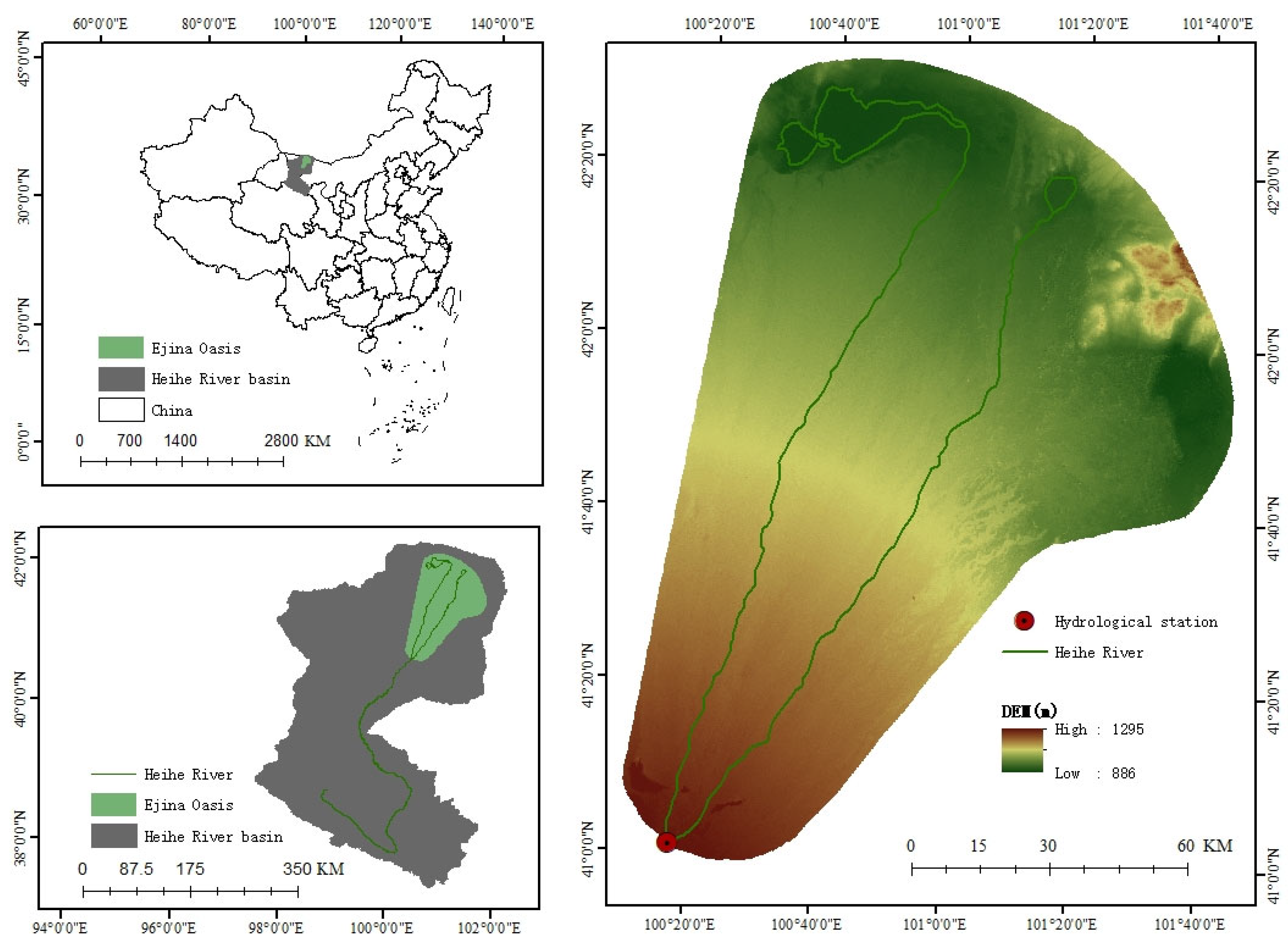
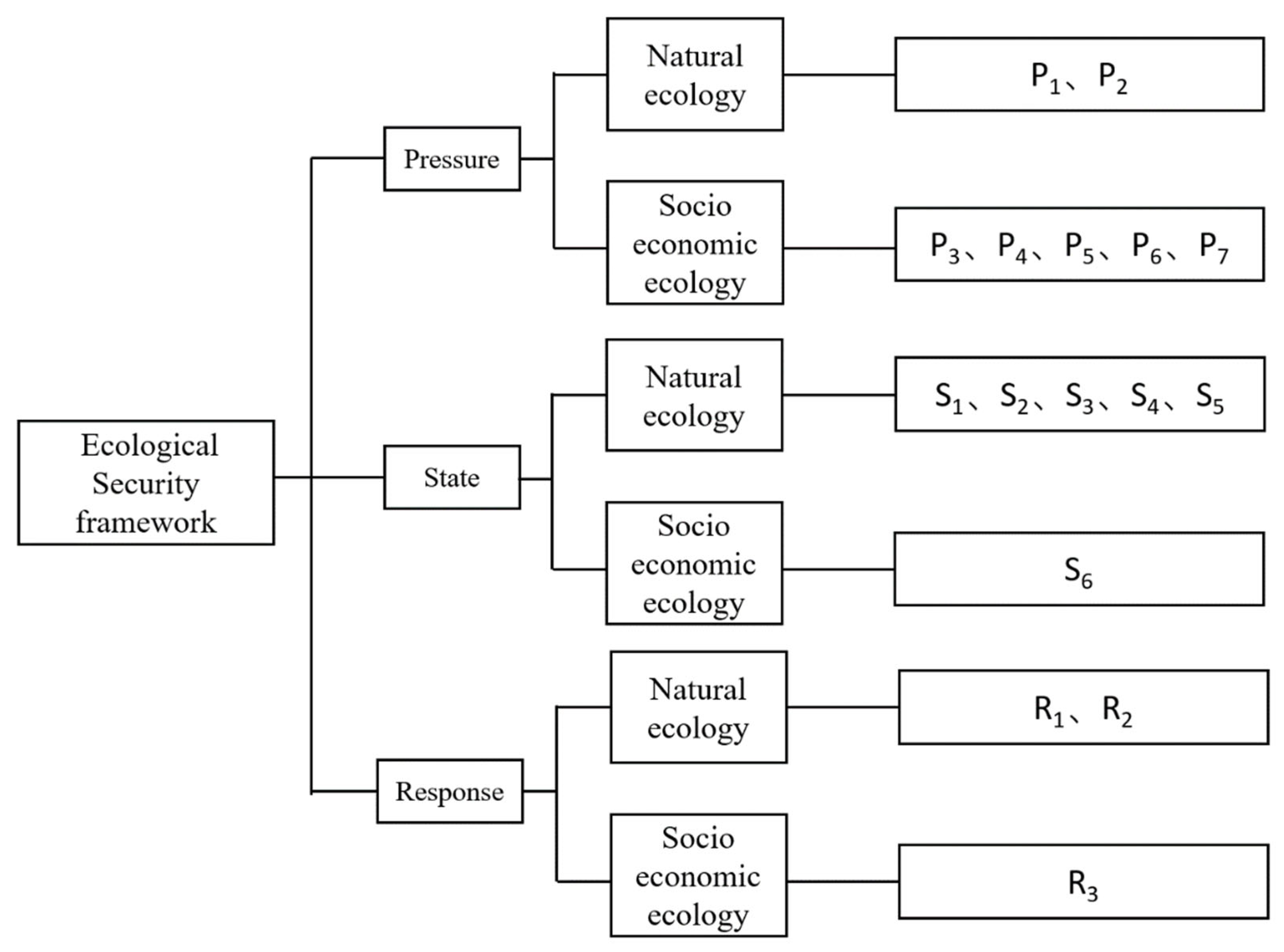
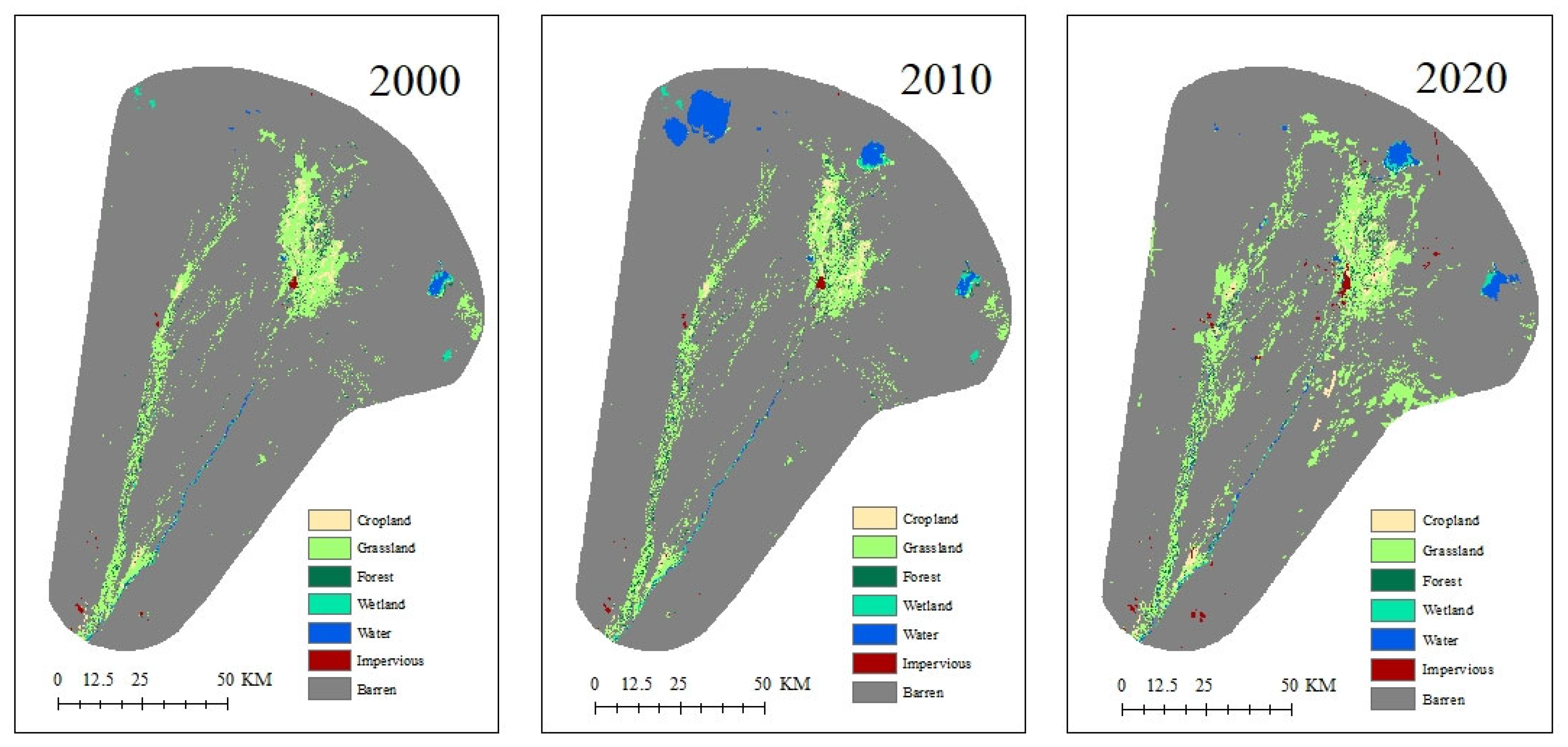
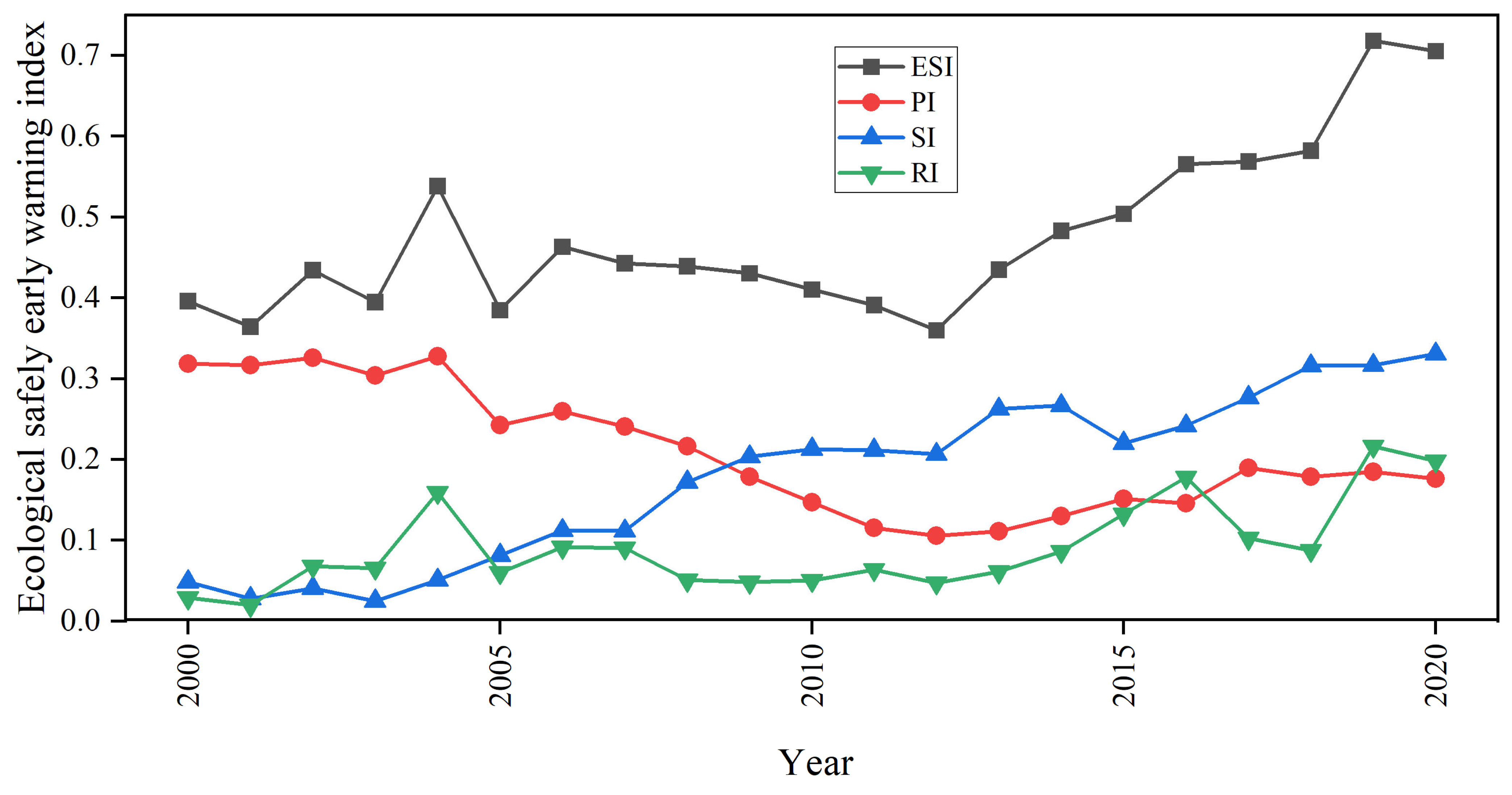
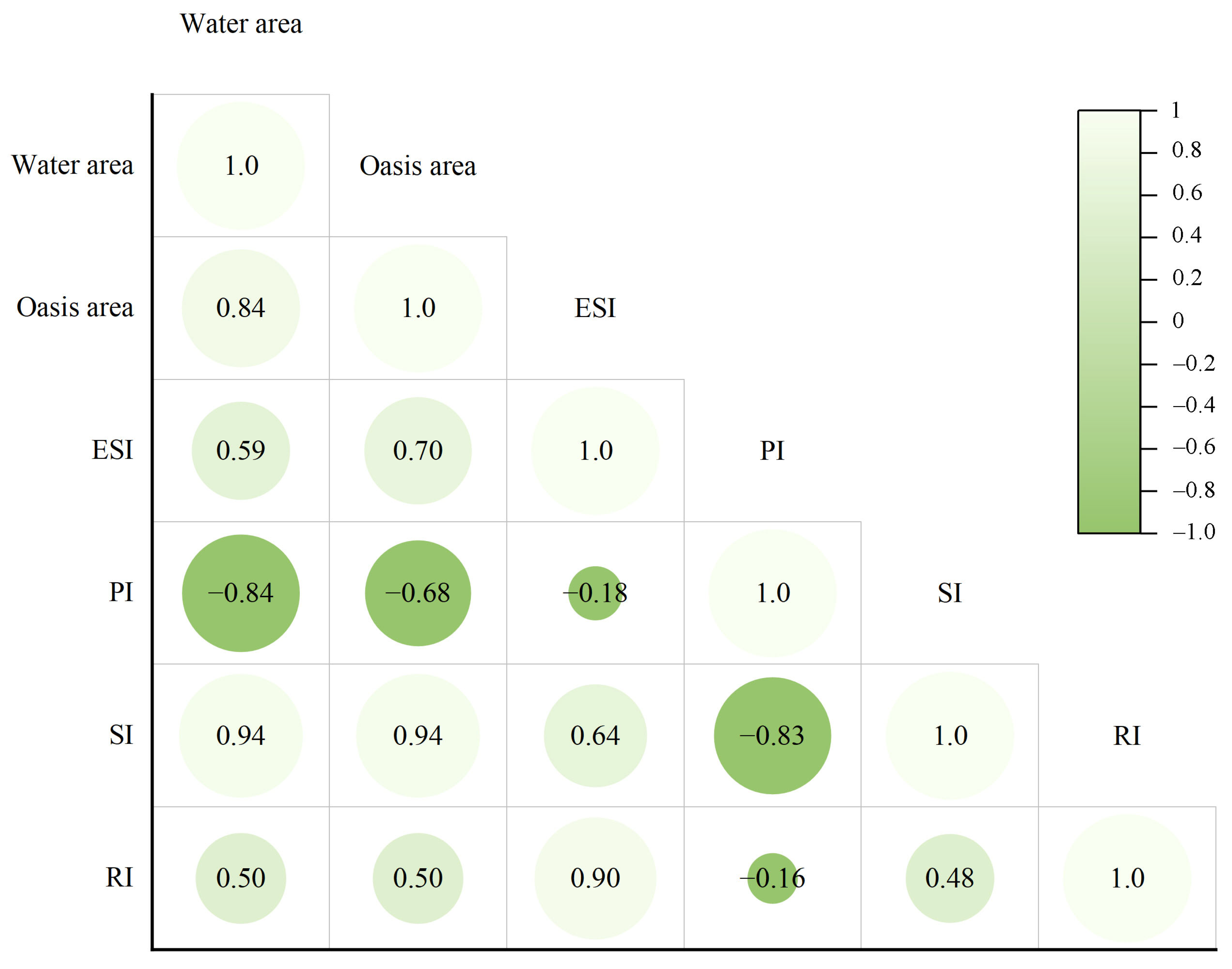
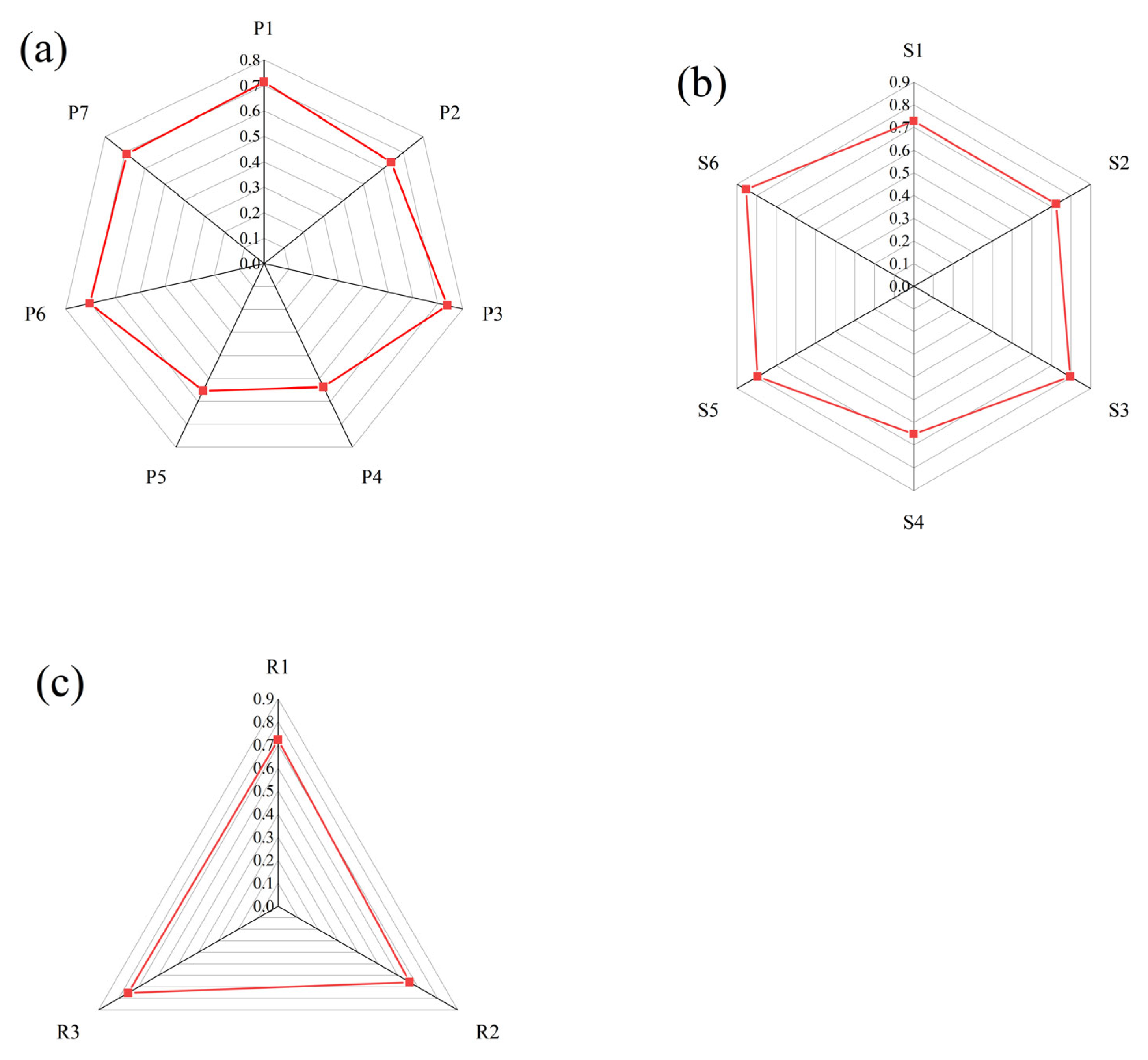
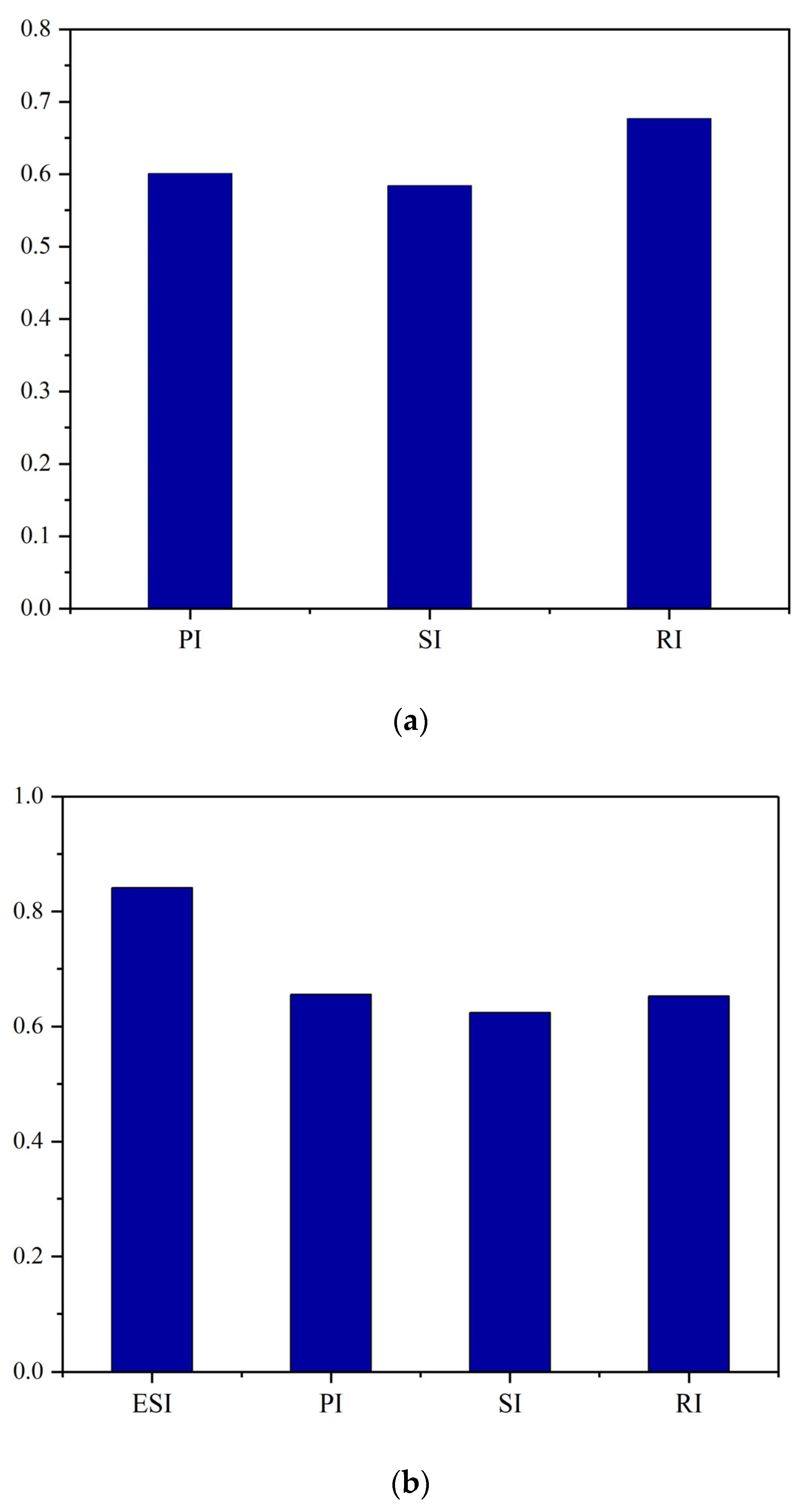
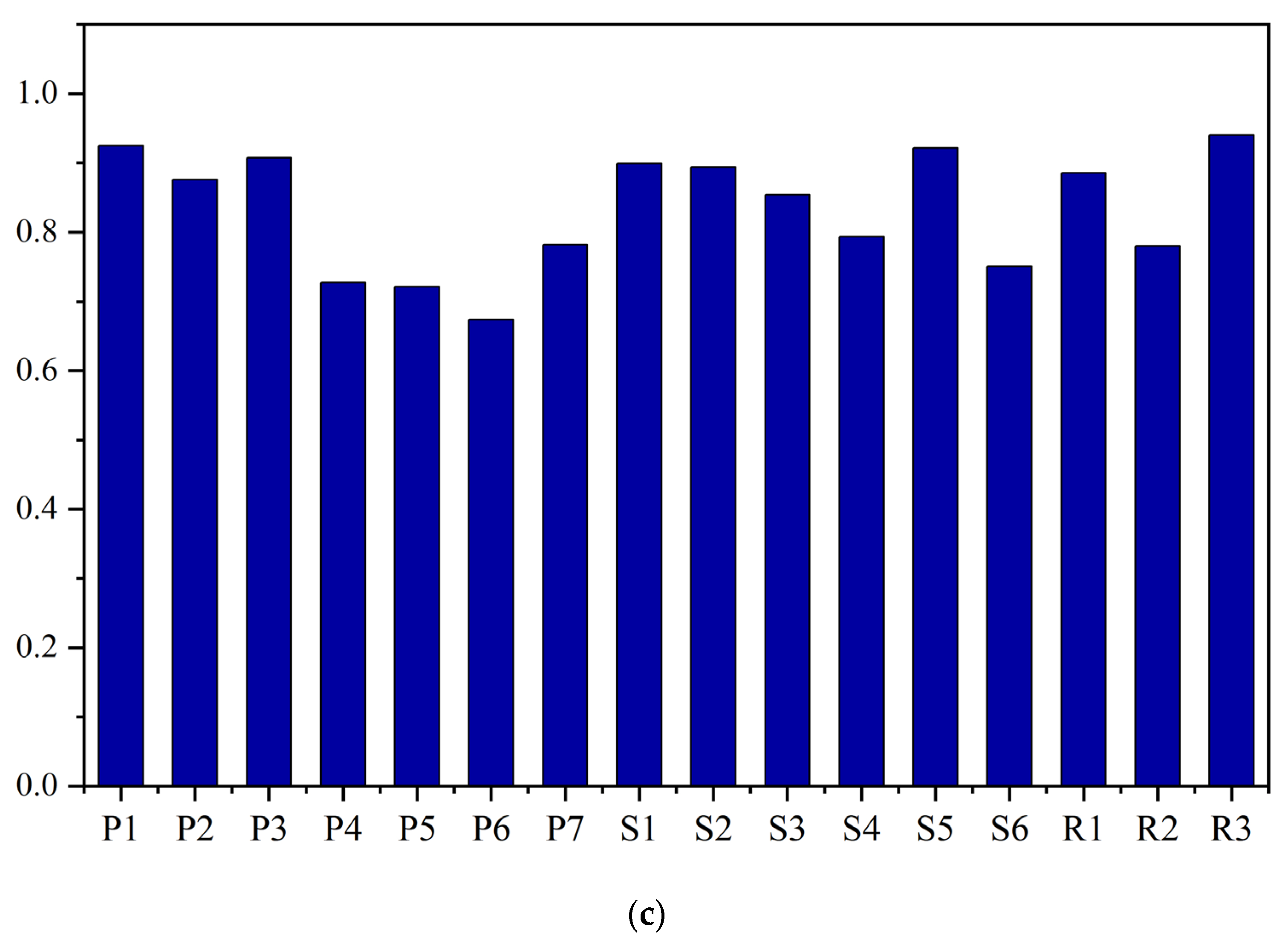
| Indicator Layers | Descriptions of Indicators |
|---|---|
| Habitat degradation degree | The level of habitat degradation degree score indicates the degree of land use type by the degree of coercion of stress factors, and a higher the habitat degradation degree indicates that the land use type is threatened by the higher degree of vulnerability. |
| Total population | Increase in total population indirectly affects changes in land-use types while increasing water demand. |
| GDP | GDP growth is usually accompanied by an increase in environmental pollution and demand for water resources, and at the same time, it affects changes in land use types. |
| Cultivated land area | Expansion of arable land can lead to degradation of grasslands and woodlands, while agricultural water use crowds out ecological water use, causing ecological deterioration. |
| Amount of agricultural fertilizer | An increase in the amount of agricultural fertilizer means an increase in environmental pollution. |
| The primary industry proportion | An increase in the proportion of primary industry implies an expansion of agricultural production, which usually affects the type of land use and water demand. |
| The secondary industry proportion | An increase in the proportion of secondary industry implies an expansion of industrial production, which usually leads to environmental pollution. |
| Carbon stock | An increase in carbon stock means an increase in the ecosystem carbon sequestration capacity, which can measure the health of ecosystems. |
| Habitat quality | Habitat quality measures the health and integrity of ecosystems. |
| East Juyan Sea’s lake surface area | After the breakup of the Heihe River, the Juyan Sea gradually dried up, and after the implementation of the water diversion project, the surface area of the lake gradually stabilized, which is used to characterize the health of water resources in the basin. |
| Aridity index | Aridity index describes the impact of rainfall and evapotranspiration on oases in arid zones. |
| FVC | Fractional vegetation cover expresses the distribution and density of plants on the surface and has a profound effect on the structure and functioning of ecosystems. |
| Per capita GDP | Higher GDP per capita means local capacity to invest in environmental protection. |
| The volume of water discharged from Wolf Heart Mountain | The amount of water reaching the Wolf Heart Mountain Hydrological Station after the implementation of the water diversion project, which should be used for the ecological restoration of the Ejina Oasis and the maintenance of the surface area of the Juyan Sea. |
| The inflow of water into East Juyan Sea | The amount of water that reaches the end lake after distribution is used to keep the lake healthy. |
| The tertiary industry proportion | An increase in the proportion of the tertiary sector means an expansion of the service economy, and the improvement of the ecological environment in the Ejina Oasis attracts tourists to come to see the poplar forests, and the increase in the tourism economy in turn stimulates the protection of the ecological environment. |
| Indicator Layer | Directional | Indicator Entropy | Indicator Weights |
|---|---|---|---|
| Habitat degradation degree | - | 0.9558 | 0.0500 |
| Total population | - | 0.9982 | 0.0020 |
| GDP | - | 0.9286 | 0.0807 |
| Cultivated land area | - | 0.9415 | 0.0662 |
| Amount of agricultural fertilizer | - | 0.9628 | 0.0421 |
| The primary industry proportion | - | 0.9790 | 0.0238 |
| The secondary industry proportion | - | 0.8873 | 0.1275 |
| Carbon stock | + | 0.9121 | 0.0995 |
| Habitat quality | + | 0.9528 | 0.0534 |
| East Juyan Sea’s lake surface area | + | 0.9805 | 0.0221 |
| Aridity index | - | 0.9981 | 0.0022 |
| FVC | + | 0.9287 | 0.0806 |
| Per capita GDP | + | 0.9066 | 0.1057 |
| The volume of water discharged from Wolf Heart Mountain | + | 0.9628 | 0.0420 |
| The inflow of water into East Juyan Sea | + | 0.9593 | 0.0461 |
| The tertiary industry proportion | + | 0.8620 | 0.1561 |
| Ecological Security Level | Security Index | Degree of Ecological Security | Characterization of the Ecological Security Level. |
|---|---|---|---|
| V | ESI ≤ 0.2 | Very unsafe | Severe degradation of ecosystem services, inferior resistance to disturbance, poor self-recovery, and ecosystems in a very insecure state. |
| IV | 0.2 < ESI ≤ 0.4 | Insecurity | Ecological font services are degraded, less resistant to disturbance, less able to recover themselves, and ecosystems are in an insecure state. |
| III | 0.4 < ESI ≤ 0.6 | Critical safety | Ecosystems are in a state of critical safety, although they have suffered a certain degree of disruption, but are still within their capacity to recover and withstand a certain degree of disturbance. |
| II | 0.6 < ESI ≤ 0.8 | Safer | Minor degradation of ecosystem services, strong resistance to disturbance and self-recovery, and ecosystems in a relatively secure state. |
| I | ESI > 0.8 | Ideal security | Ecosystem services are not degraded, are highly resistant to disturbance, do not require self-restoration, and ecosystems are in a state of ideal security. |
| Type of Land Use/km2 | 2000 | 2010 | 2020 |
|---|---|---|---|
| Cropland | 95.65 | 104.74 | 137.33 |
| Grassland | 909.85 | 805.59 | 1318.87 |
| Forest | 63.88 | 89.54 | 81.99 |
| Oasis (include grassland and forest) | 1069.38 | 999.87 | 1538.19 |
| Wetland | 41.29 | 53.29 | 33.30 |
| Water | 44.87 | 254.53 | 125.79 |
| Total water (include wetland and water) | 86.16 | 307.82 | 159.09 |
| Impervious | 14.54 | 15.63 | 48.69 |
| Barren | 12,870.88 | 12,717.65 | 12,294.99 |
| 2000–2010 | 2010–2020 | 2000–2020 | ||||
|---|---|---|---|---|---|---|
| Type of Land Use | Growth/km2 | Annual Expansion Rate % | Growth/km2 | Annual Expansion Rate % | Growth/km2 | Annual Expansion Rate % |
| Cropland | 9.08 | 9.50 | 32.60 | 31.12 | 41.68 | 43.57 |
| Grassland | −104.26 | −11.46 | 513.29 | 63.72 | 409.03 | 44.96 |
| Forest | 25.66 | 40.17 | −7.55 | −8.43 | 18.11 | 28.35 |
| Oasis (include grassland and forest) | −69.51 | −6.5 | 538.32 | 53.84 | 468.81 | 43.91 |
| Wetland | 12.01 | 29.08 | −20.00 | −37.52 | −7.99 | −19.36 |
| Water | 209.66 | 467.30 | −128.74 | −50.58 | 80.92 | 180.36 |
| Total water (include wetland and water) | 221.66 | 257.27 | 148.73 | 48.32 | 72.93 | 84.64 |
| Impervious | 1.09 | 7.48 | 33.06 | 211.52 | 34.15 | 234.82 |
| Barren | −153.24 | −1.19 | −422.66 | −3.32 | −575.90 | −4.47 |
Disclaimer/Publisher’s Note: The statements, opinions and data contained in all publications are solely those of the individual author(s) and contributor(s) and not of MDPI and/or the editor(s). MDPI and/or the editor(s) disclaim responsibility for any injury to people or property resulting from any ideas, methods, instructions or products referred to in the content. |
© 2024 by the authors. Licensee MDPI, Basel, Switzerland. This article is an open access article distributed under the terms and conditions of the Creative Commons Attribution (CC BY) license (https://creativecommons.org/licenses/by/4.0/).
Share and Cite
Shi, X.; Jiang, X.; Liu, Y.; Wu, Q.; Zhang, Y.; Li, X. Evaluation of the Evolution of the Ecological Security of Oases in Arid Regions and Its Driving Forces: A Case Study of Ejina Oasis in China. Sustainability 2024, 16, 1942. https://doi.org/10.3390/su16051942
Shi X, Jiang X, Liu Y, Wu Q, Zhang Y, Li X. Evaluation of the Evolution of the Ecological Security of Oases in Arid Regions and Its Driving Forces: A Case Study of Ejina Oasis in China. Sustainability. 2024; 16(5):1942. https://doi.org/10.3390/su16051942
Chicago/Turabian StyleShi, Xiaowei, Xiaohui Jiang, Yihan Liu, Quanlong Wu, Yichi Zhang, and Xiuqiao Li. 2024. "Evaluation of the Evolution of the Ecological Security of Oases in Arid Regions and Its Driving Forces: A Case Study of Ejina Oasis in China" Sustainability 16, no. 5: 1942. https://doi.org/10.3390/su16051942
APA StyleShi, X., Jiang, X., Liu, Y., Wu, Q., Zhang, Y., & Li, X. (2024). Evaluation of the Evolution of the Ecological Security of Oases in Arid Regions and Its Driving Forces: A Case Study of Ejina Oasis in China. Sustainability, 16(5), 1942. https://doi.org/10.3390/su16051942





